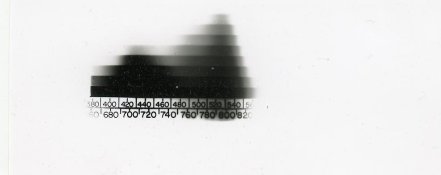The evidence above is that pyro stain does not correspond to VC filtration. It seems its pass-band is wrong for effecting contrast. It's not the right color.
Pyro stain, it seems, blocks both actinic green and blue - making it ineffective as a contrast filter.
The so-called evidence above does not show that the stain can affect contrast with VC papers because the tests used to derive the "evidence" were flawed in design.
The flaw is that a uniform stain was applied to the step wedge exposures and that's not the state of the stain in a pyro-developed negative. The stain is not uniform, it varies proportionally to the amount of silver present in the negative.
You also have come to a conclusion that the color of the pyro stain is not the "right color". You can tell this with your eye? What then do you think would be the right color?
To affect the contrast of a VC paper, we need to modify the light so that the ratio of blue light to green light changes from the highlights to the shadows. Your test only looked at the added filtration that would be seen in the highlights, but it doesn't address the amount of filtration that would be present in the shadows. To determine this, I did some tests a few years ago...
Here's the results from one of those tests - I took some negatives that were developed in PMK and Pyrocat and I bleached the silver from the negatives. I then cut some of the wedge steps out of the negatives and put them into a scanning spectrophotometer and measured the absorbance of the stain in the films from these two developers and compared the results. I scanned them from near IR to well into the UV.
See the link below for a bit more info:
http://keyesphoto.com/Resource/TechInfo/Kirk_D_Keyes-PMK_vs_Pyrocat_scan.pdf
Notice that both the PMK and Pyrocat stains have more absorbance in the blue and UV spectrum than they do in the green. (For VC papers, we really only need to look at the blue and green wavelengths.) Additionally, that absorbance increases when the amount of developed silver increases in the processed film. It's this change in absorbance that affects the response of the VC paper to stained negatives - not just some amount of stain that is unvarying in the neg, as your test used.
That's what your tests do not address.
By the way - Negatives from non-staining developers show very little absorbance all the way across the visible wavelengths.
(Also note that the Pyrocat stain has a large increase in the UV as well as less overall absorbance in the visible wavelengths - it's this property that I think prompted Sandy King to persue the use of pyrocatechol (used in Pyrocat) over pyrogallol (used in PMK) as he was interested in it's use as a developer for non-silver printing processes and he wanted a clearer stain for visible light processes.)
Look at the two PMK plots - the dark blue plot is from a highlight area on the negative with the silver removed and the light blue plot from the base+fog of the same film (similar to a very deep shadow area of a neg). At 500nm in the green region, the difference in absorbance between the two plots is only about 0.16 Abs (0.50-0.34=0.16). At 420 nm in the blue region, the difference in absorbance between the two plots is about 0.54 Abs. (0.98-0.44=0.54).
That means the highlights in this film had about 0.38 Abs more in the blue wavelength relative to the green. That is, it had less exposure from blue light. The added blue absorbance is the same as putting in more yellow filtration on your enlarger.
But how much affect does this have in actual printing situations? Since the absorbance curves for neither PMK or Pyrocat are perfectly flat, it's hard to say without more testing. Looking at the amount of blue that is being absorbed relative to the green that is still being transmitted, I guess from this data that it's about a 30 or 40 Y difference in enlarger filtration.
Since the shadow areas of the neg are going to have a little more blue Abs than the base+fog did in my test films, I'd say for practical purposes, it ends up being that the contrast changes about 25Y filtration going from the shadows to the highlights, or maybe 1/2 grade for a neg that is printing with no filtration or with a #2 filter. Of course, this amount of yellow filtration is going to get swamped by a #0 or a #5 filter, and some of it will be lost even with less extreme filtration settings.
So yes, the stain has little effect with a grade #5 filter or a grade #0 filter, but with a neg that prints with a grade #2 or #3 filter, the highlights will be compressed a bit. Think about it this way, it's like adding a bit of yellow filtration only to the highlights, and not much to the shadows - and that will affect the overall contrast of the neg if printed without much other filtration in the pack.















